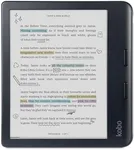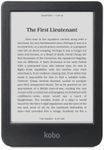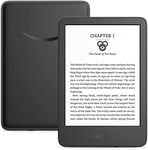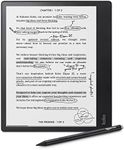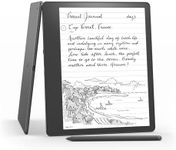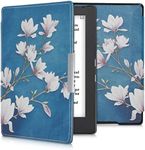Buying Guide for the Best E Readers
Choosing the right e-reader can make your reading experience much more enjoyable and convenient. E-readers are designed to mimic the look of paper, reduce eye strain, and offer portability for book lovers. When picking an e-reader, it's important to think about how, where, and what you like to read. Consider whether you read mostly at home or on the go, if you prefer reading at night, and if you want to access a wide range of books or just a few favorites. Understanding the key features will help you find an e-reader that fits your habits and preferences.Screen SizeScreen size refers to the diagonal measurement of the e-reader's display, usually in inches. This is important because it affects how much text fits on the screen and how portable the device is. Smaller screens, around 6 inches, are lightweight and easy to carry, making them great for travel or one-handed reading. Medium screens, about 7 to 8 inches, offer a balance between portability and a comfortable reading area. Larger screens, 9 inches or more, are ideal for reading PDFs, comics, or if you prefer bigger text. Choose a screen size based on where you plan to use your e-reader and what types of content you enjoy most.
Display Type and ResolutionMost e-readers use e-ink displays, which are designed to look like real paper and reduce glare, making them easy on the eyes. Resolution, measured in pixels per inch (PPI), determines how sharp the text and images appear. Lower resolutions (around 150-200 PPI) are fine for basic reading, but higher resolutions (300 PPI or more) make text crisper and images clearer, which is especially nice for graphic novels or detailed documents. If you read for long periods or enjoy illustrated books, a higher resolution display will provide a more pleasant experience.
Front Light and Adjustable WarmthA front light allows you to read in low light or at night without needing an external lamp. Some e-readers also offer adjustable warmth, which lets you change the color tone of the light from cool to warm. This can reduce eye strain and make nighttime reading more comfortable. If you often read in bed or in dim environments, look for an e-reader with a built-in front light and adjustable warmth to suit your preferences.
Battery LifeBattery life indicates how long the e-reader can operate before needing a recharge. E-readers are known for their long battery life, often lasting weeks on a single charge. However, using features like front lighting or Wi-Fi can reduce this time. If you travel frequently or don't want to worry about charging often, choose a model known for extended battery life. For most users, any modern e-reader will last long enough for regular use.
Storage CapacityStorage capacity tells you how many books, documents, or comics you can keep on your device. Most e-readers offer enough space for thousands of books, with common options ranging from 4GB to 32GB or more. If you mostly read text-based books, even the smallest storage is usually enough. If you like to keep a large library, read graphic novels, or store audiobooks, consider a model with more storage.
Water ResistanceWater resistance means the e-reader can handle splashes or even brief submersion in water. This is important if you like to read by the pool, at the beach, or in the bath. Devices with water resistance are rated with an IPX standard, which tells you how much water exposure they can handle. If you plan to use your e-reader in wet environments, look for a water-resistant model for peace of mind.
File and Format SupportDifferent e-readers support different file types, such as EPUB, PDF, MOBI, and more. Some also let you borrow library books or read comics. If you have a specific collection of books or want to access content from various sources, check which formats the e-reader supports. Make sure the device can handle the types of files you plan to read most often.
Connectivity (Wi-Fi, Cellular, Bluetooth)Connectivity options determine how you download books and connect to other devices. Wi-Fi is standard and lets you buy or borrow books directly on the device. Some e-readers offer cellular connectivity for downloading books anywhere, but this is less common. Bluetooth allows you to listen to audiobooks with wireless headphones. Choose the connectivity features that match your reading and listening habits.

